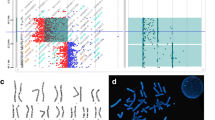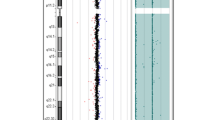Abstract
Human paternal uniparental disomy for chromosome 14 (upd(14)pat) presents with skeletal abnormalities, joint contractures, dysmorphic facial features and developmental delay/mental retardation. Distal human chromosome 14 (HSA14) is homologous to distal mouse chromosome 12 (MMU12) and both regions have been shown to contain imprinted genes. In humans, consistent radiographic findings include a narrow, bell-shaped thorax with caudal bowing of the anterior ribs, cranial bowing of the posterior ribs and flaring of the iliac wings without shortening or dysplasia of the long bones. Mice with upd(12)pat have thin ribs with delayed ossification of the sternum, skull and feet. In both mice and humans, the axial skeleton is predominantly affected. We hypothesize that there is an imprinted gene or genes on HSA14/MMU12 that specifically affects rib/thorax development and the maturation of ossification centers in the sternum, feet and skull with little effect on long bone development.





Similar content being viewed by others
References
Berend SA, Horwitz J, McCaskill C, Shaffer LG (2000) Identification of uniparental disomy following prenatal detection of robertsonian translocations and isochromosomes. Am J Hum Genet 66:1787–1793
Cotter PD, Kaffe S, McCurdy LD, Jhaveri M, Willner JP, Hirschhorn K (1997) Paternal uniparental disomy for chromosome 14: a case report and review. Am J Med Genet 70:74–79
Coveler KJ, Yang SP, Sutton VR, Milstein JM, Wu YQ, Knox-DuBois C, Beischel LS, Johnson JP, Shaffer LG (2002) A case of segmental paternal isodisomy of chromosome 14. Hum Genet 110:251–256
Georgiades P, Watkins M, Surani MA, Ferguson-Smith AC (2000) Parental origin-specific developmental defects in mice with uniparental disomy for chromosome 12. Development 127(21):4719–28
Gothe S, Wang Z, Ng L, Kindblom JM, Barros AC, Ohlsson C, Vennstrom B, Forrest D (1999) Mice devoid of all known thyroid hormone receptors are viable but exhibit disorders of the pituitary-thyroid axis, growth, and bone maturation. Genes Dev 13(10):1329–41
Kurosawa K, Sasaki H, Sato Y, Yamanaka M, Shimizu M, Ito Y, Okuyama T, Matsuo M, Imaizumi K, Kuroki Y, Nishimura G. (2002) Paternal UPD14 is responsible for a distinctive malformation complex. Am J Med Genet 110:268–272
McLeod MJ (1980) Differential staining of cartilage and bone in whole mouse fetuses by alcian blue and alizarin red S. Teratology 22(3):299–30
Miyoshi N, Wagatsuma H, Wakana S, Nomura M, Aisaka K, Kohda T, Surani MA, Kaneko-Ishino T, Ishino F (2000) Identification of an imprinted gene, Meg3/Gtl2 and its human homologue MEG3, first mapped on mouse distal chromosome12 and human chromosome 14q. Genes Cells 5:211–220
Rawls A, Wilson-Rawls J, Olson EN (2000) Genetic regulation of somite formation. Curr Top Dev Biol 47:131–154
Schmidt JV, Matteson PG, Jones BK, Guan X-J, Tilghman SM (2000) The Dlk1 and Gtl2 genes are linked and reciprocally imprinted. Genes Dev 14:1997–2002
Schuster-Gossler K, Bilinski P, Sado T, Ferguson-Smith A, Gossler A (1998) The mouse Gtl2 gene is differentially expressed during embryonic development, encodes multiple alternatively spliced transcripts, and may act as an RNA. Dev Dyn 212(2):214–28
Shimoda M, Morita S, Obata Y, Sotomaru Y, Kono T, Hatada I (2002) Imprinting of a small nucleolar RNA gene on mouse chromosome 12. Genomics 79(4):483–6
Sutton VR, Shaffer LG (2000) Search for imprinted regions on chromosome 14: comparison of maternal and paternal UPD cases with cases of chromosome 14 deletion. Am J Med Genet 93:381–387
Takada S, Tevendale M, Baker J, Georgiades P, Campbell E, Freeman T, Johnson MH, Paulsen M, Ferguson-Smith AC (2000) Delta-like and Gtl2 are reciprocally expressed, differentially methylated linked imprinted genes on mouse chromosome 12. Curr Biol 10:1135–1138
Tsai C, Lin S, Ito M, Takagi N, Takada S, Ferguson-Smith A (2002) Genomic imprinting contributes to thyroid hormone metabolism in the mouse embryo. Curr Biol 12(14):1221–1226
Villar AJ, Carlson EJ, Gillespie AM, Ursell PC, Epstein CJ (2001) Cardiomyopathy in mice with paternal uniparental disomy for chromosome 12. Genesis 30(4):274–9
Walter CA, Shaffer LG, Kaye CI, Huff RW, Ghidoni PD, McCaskill C, McFarland MB, Moore CM (1996) Short-limb dwarfism and hypertrophic cardiomyopathy in a patient with paternal isodisomy 14:45,XY,idic(14)(p11). Am J Med Genet 65:259–265
Wang JCC, Passage MB, Yen PH, Shapiro LJ, Mohandas TK (1991) Uniparental heterodisomy for chromosome 14 in a phenotypically abnormal familial balanced 13/14 robertsonian translocation carrier. Am J Hum Genet 48:1069–1074
Wylie AA, Murphy SK, Orton TC, Jirtle RL (2000) Novel imprinted DLK1/GTL2 domain on human chromosome 14 contains motifs that mimic those implicated in IGF2/H19 regulation. Genome Res 10(11):1711–8
Yano S, Li L, Owen S, Wu S, Tran T (2001) A further delineation of the paternal uniparental disomy (UPD) 14: The fifth reported liveborn case. (Abstract) Am J Hum Genet 69 (suppl.): A739
Acknowledgements
Thanks to Rhodora Gacayan and Marguerite Doan for excellent animal care. This work was supported in part by grants from the National Institutes of Health (V.R.S., L.G.S., B.L.), Arthritis Foundation (B.L.) and the March of Dimes (B.L. and L.G.S.).
Author information
Authors and Affiliations
Corresponding author
Rights and permissions
About this article
Cite this article
Sutton, V.R., McAlister, W.H., Bertin, T.K. et al. Skeletal defects in paternal uniparental disomy for chromosome 14 are re-capitulated in the mouse model (paternal uniparental disomy 12). Hum Genet 113, 447–451 (2003). https://doi.org/10.1007/s00439-003-0981-x
Received:
Accepted:
Published:
Issue Date:
DOI: https://doi.org/10.1007/s00439-003-0981-x




